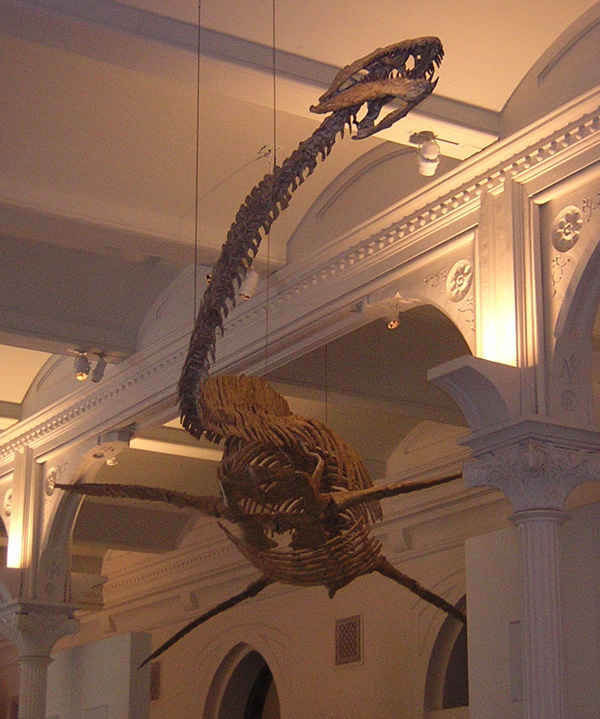First up was the video documentation of a grey seal taking down a pacific giant octopus. Now the press around this rarely documented occurrence sounded off like it was a clash of deep sea monsters but at no time in the event did the harbor seal look at all worried or in danger. It probably has done this before and we know that pinnipeds do kill fairly large stuff all the time. Of course if you are familiar with my thoughts on plesiosaurs I do imagine them as being a bit not unlike pinnipeds in rarely being heralded as the opportunistic marine mesopredators that they are. Anyways keep in mind the way that the octopus sucks onto the back end of the seal to evade it and the general tactic of latching onto your predator.
And then there was the video of a fairly large octopus slipping through a very small crack on the side of a boat to get back in the water. I know we have all heard that they could do this but to see them do it is a different thing!!
Of course I would be remiss not to mention the recent publication of TWO new giant Mesozoic cephalopods from Japan. One of them was a modest sized relative of vampire squids (which are not vampiric and not squids but closer to octopi) but the other, also found from solely the chitinous beak, suggests a squid approaching the larger squid found in todays oceans.
 |
| Lower jaw Haboroteuthis poseidon. 2015 Tanabe et. al. |
Now it is no great mystery that plesiosaurs of all flavors exploited ammonites as they have been preserved in the stomach contents of both polycotylids and elasmosaurids. Such invertebrate prey was common and small enough to be swallowed whole or crunched in the palate with the gastric mill possibly doing the rest of the chewing. And although most wikipedia entries on plesiosaurs (long necked) usually emphasis fish, belemnites and squid as their primary prey it is generally not controversial that smallish ammonites were dined upon by plesiosaurs.
 |
| Aristonectes pursuing ammonite meal. Used w/permission christopher 252 deviantart |
What I want to expand upon is an idea of mine that many plesiosaurs did not curtail dining on the larger ammonite species found throughout the Mesozoic and indeed that some species may have preyed upon the largest ammonites which were indeed monstrous. It is not a coincidence in my view that the largest elasmosaurids overlapped in time and space with the largest ammonites in the Cretaceous.
But first lets explore how plesiosaurs may have consumed more modest sized ammonites - species of which may have been one or two feet across and may have been more common than the big ones and therefore been more of a mainstay in plesiosaur diets. Let us go over some characteristics of ammonites that made them vulnerable to predation.
 |
| c/o Duane Nash. Western Foundation Vertebrate Zoology |
Above is saggital section of an ammonite shell displaying the buoyant septae chambers but what should also be apparent is that the living chamber is broken off. In fact the vast majority of ammonites are missing the living chamber. Why is this? Predators may have broken it off but a more mundane and pragmatic reason is that diagenetic processes during preservation would have broken it off. Perhaps the living chamber being flooded with sediment and uffering less structural support to withstand crushing. To get an idea of how much bigger these animals would have been I zoomed in on some smaller, but more fully complete ammonites you can see in the bottom right on the slab above.
 |
| c/o Duane Nash. Western Foundation Vertebrate Zoology |
So unless you can see a fully preserved living chamber (the final and largest septae) in the ammonite you are looking at you can imagine the living animal may have been much larger. And the shell itself was vulnerable to high pressure - from either a predators bite or too much water pressure at great depth. That means if brought to great depths the shell will literally implode due to too high a pressure as is the case with modern nautilus. Could this have been a particularly ingenious predatory tactic? Dragging ammonites to great depth to make them implode? Its possible but plesiosaurs likely had other more sensible tactics.
So if an ammonite prove too large to swallow or crush through via biting how to evict your cephalopod meal from its shell? First and foremost is to grab an exposed part of the animal - a tentacle or whatever exposed bit the plesiosaur can get its teeth on. Here the stealth tactics and long neck of plesiosaurs come in handy in getting the jump on the ammonite before it can retreat into its shell. Remember with that long neck, especially in murky, dark, or deep conditions it allows the plesiosaur to get within biting distance without alerting its presence via a pressure wave.
A little bit here on ammonite anatomy. Although still controversial (as many things are regarding ammonite soft anatomy) the strange aptychus found associated with ammonite remains likely served as a protective two valved closing hatch to secure the animal away from outside danger.
 |
| Wiki. Diagram of possible use of aptychi as closing mechanism |
 |
| credit Robert Lamanis |
Regardless of how this whole set up worked for ammonites they likely had a way to shut themselves into their shell so getting a securing bite is of paramount importance for plesiosaurs and many had the dental armament to do this. Indeed plesiosaur heads can be seen as squeezing as much teeth, eyes, and jaw closing muscles in as small a space as possible.
And now that the plesiosaur has a good grip on this ammonite (again we are talking midsized ammonite - couple feet across) it can give it a nice shake and sometimes this might be good enough to shake the morsel out of its shell. Ammonites may have been especially vulnerable as they outgrew their old living chamber they had to slither into their new living chamber and the muscle attachments to the new chamber were not secure.
But if shaking underwater did not do the trick and there were no other plesiosaurs around to help dismember the shelled cephalopod time to drag it the surface and start bashing it against the topside.
 |
| CA Sea Lion thrashing apart Mola mola Monterey Bay. credit Bill Schmoker |
Plesiosaurs were strong animals. It is unfortunate that so many of the more popular depictions of plesiosaurs depict them as way too gaunt, famished, and shrink-wrapped (that is a future post topic). They have thick, heavy muscular torsos, and tall, strong dorsal spinous processes that anchored strong ligaments and musculature - especially where the neck met the torso. These were powerful animals and could mete out a thrashing to whatever was impaled on their teeth. And don't forget, water is heavy.
 |
| Thalassomedon, Adam Smith. |
 |
| Thalassomedon. Adam Smith. Note tall vertebral processes that anchored strong musculature |
 |
| Thalassomedon, a powerful predator. wiki |
Ok now that I have warmed you up maybe to plesiosaurs taking on medium sized ammonites - what about those big boys, massive ammonites that may in fact represent the largest invertebrates ever evolved? Yep I think plesiosaurs - especially elasmosaurids - were especially apt to consume huge ammonites. Too heavy to lift out and smash against the surface of the water plesiosaurs could have used rotational twisting to leverage the animal out of its living chamber. Have you ever seen a guinea worm spun out of its home in human flesh? Yeah kinda like that. That long neck comes in useful because as the cephalopod wraps itself around it (see the video above of giant octopus and harbor seal) the neck serves as a sort of winch to spin out the cephalopod. If one plesiosaur could not get the proper leverage to evict the cephalopod then other plesiosaurs could have assisted in stabilizing the animal from spinning as one or more plesiosaurs twisted, yanked, and pulled the poor writhing beast from its shell. Let me remind you of the strange rugose markings noted on the lingual side of the jaw in Zarafasaura - perhaps from holding onto the shells of ammonites. Of course I went over all this before but I gots to keep beating that drum - plesiosaurs were some tough cookies and imo not at all the constant whipping boys of other marine reptiles and limited to "small fry" for prey. After all if they were actually gape limited predators why not evolve an elongated or "longirostine" style jaw like you see in gharials, alligator gar, or delphinids? We see polycotylid plesiosaurs develop this longirostine style of jaw - why not long necked plesiosaurs? Why do long necked plesiosaurs have fused mandibular symphysis and a lower jaw that is completely fused? After all having a flexible lower jaw that can bow out a bit and accept larger objects is useful (especially for swallowing fish) and clearly evolved in related lizards and snakes. These anachronisms make more sense if we invoke rotational feeding and a propensity to bite into and prey upon stuff larger than previously assumed. Brevirostine jaws, fused symphysis, and solid lower mandibles all speak to these jaws sustaining large strain. Strain which was transmitted down and absorbed by the large neck and robust body. And don't be fooled by the relatively small head and less than stout like teeth. In the largest elasmosaurs the head was still impressive and approached close to two feet long. Teeth were often two inches long, well rooted and would not look out of place in the jaws of a nile crocodile. And the teeth were far more robust than the teeth of modern boa snakes which latch onto quite large and vigorous terrestrial prey. We do have a lot of plesiosaur teeth interestingly still pretty sharp but broken off at the root - perhaps due to vigorous struggles? Anyways without further ado I present a better illustrated visage of what I imagine this scene would have looked like featuring a non-specific heteromorph ammonite and a non-specific elasmosaur. You should note the "girthiness" of the elasmosaurs I think they were actually that thick.
Fans of cephalopod culture should catch the strong homage I made to the vampire squid in the speculative design of this heteromorph. By the way I want to give a shout out to the book you should have bought yourself last X-mas - the book is called Heteromorph - The Rarest Fossil Ammonites and boy is it a doozie. I can not recommend it enough to anyone with even the most casual interest of those most strangest of the strange heteromorph ammonites. I can't say I have seen a dino book that holds a candle to the quality of this book put out in the last 20 years. Eventually I want to revisit it here for a book review. Below is one of many stunning full color pics from this excellent book.
Anyways I am gonna leave a purple version I did and cuz its like my birthday and shit so leave a comment for me you knuckleheads!!
Support me on Patreon.
Like antediluvian salad on facebook.
Watch me on Deviantart @NashD1.Subscribe to my youtube channel Duane Nash.
My other blog southlandbeaver.blogspot.






2 comments:
No more ideas?
At least three more posts in this series Bk: one on plesiosaur bite/capture of larger prey, one on shrink wrapping in plesiosaurs, and one on plesiosaur/mosasaur competition & niches.
Post a Comment